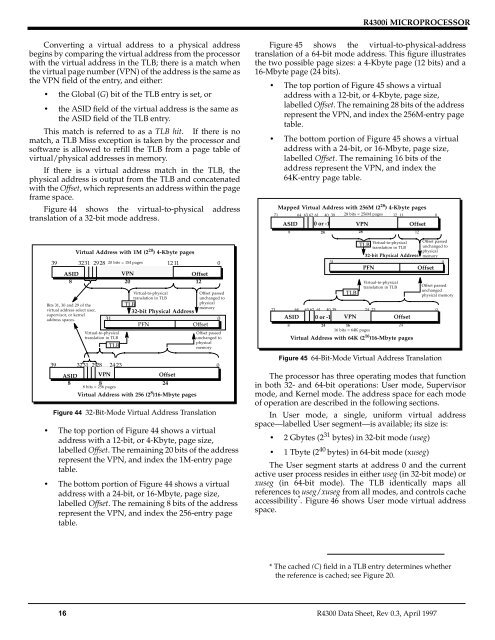R4300i Product Information - MIPS Technologies, Inc.
R4300i Product Information - MIPS Technologies, Inc.
R4300i Product Information - MIPS Technologies, Inc.
Create successful ePaper yourself
Turn your PDF publications into a flip-book with our unique Google optimized e-Paper software.
<strong>R4300i</strong> MICROPROCESSOR<br />
Converting a virtual address to a physical address<br />
begins by comparing the virtual address from the processor<br />
with the virtual address in the TLB; there is a match when<br />
the virtual page number (VPN) of the address is the same as<br />
the VPN field of the entry, and either:<br />
• the Global (G) bit of the TLB entry is set, or<br />
• the ASID field of the virtual address is the same as<br />
the ASID field of the TLB entry.<br />
This match is referred to as a TLB hit. If there is no<br />
match, a TLB Miss exception is taken by the processor and<br />
software is allowed to refill the TLB from a page table of<br />
virtual/physical addresses in memory.<br />
If there is a virtual address match in the TLB, the<br />
physical address is output from the TLB and concatenated<br />
with the Offset, which represents an address within the page<br />
frame space.<br />
Figure 44 shows the virtual-to-physical address<br />
translation of a 32-bit mode address.<br />
39<br />
39<br />
ASID<br />
8<br />
Bits 31, 30 and 29 of the<br />
virtual address select user,<br />
supervisor, or kernel<br />
address spaces.<br />
Virtual Address with 1M (2 20 ) 4-Kbyte pages<br />
3231 2928 20 bits = 1M pages 12 11 0<br />
Virtual-to-physical<br />
translation in TLB<br />
TLB<br />
VPN<br />
Offset<br />
20 12<br />
Virtual-to-physical<br />
translation in TLB<br />
TLB<br />
32-bit Physical Address<br />
3231 2928 24 23 0<br />
ASID VPN<br />
Offset<br />
8<br />
8 24<br />
8 bits = 256 pages<br />
Virtual Address with 256 (2 8 )16-Mbyte pages<br />
Offset passed<br />
unchanged to<br />
physical<br />
memory<br />
31 0<br />
PFN<br />
Offset<br />
Offset passed<br />
unchanged to<br />
physical<br />
memory<br />
Figure 44 32-Bit-Mode Virtual Address Translation<br />
• The top portion of Figure 44 shows a virtual<br />
address with a 12-bit, or 4-Kbyte, page size,<br />
labelled Offset. The remaining 20 bits of the address<br />
represent the VPN, and index the 1M-entry page<br />
table.<br />
• The bottom portion of Figure 44 shows a virtual<br />
address with a 24-bit, or 16-Mbyte, page size,<br />
labelled Offset. The remaining 8 bits of the address<br />
represent the VPN, and index the 256-entry page<br />
table.<br />
Figure 45 shows the virtual-to-physical-address<br />
translation of a 64-bit mode address. This figure illustrates<br />
the two possible page sizes: a 4-Kbyte page (12 bits) and a<br />
16-Mbyte page (24 bits).<br />
• The top portion of Figure 45 shows a virtual<br />
address with a 12-bit, or 4-Kbyte, page size,<br />
labelled Offset. The remaining 28 bits of the address<br />
represent the VPN, and index the 256M-entry page<br />
table.<br />
• The bottom portion of Figure 45 shows a virtual<br />
address with a 24-bit, or 16-Mbyte, page size,<br />
labelled Offset. The remaining 16 bits of the<br />
address represent the VPN, and index the<br />
64K-entry page table.<br />
Mapped Virtual Address with 256M (2 28 ) 4-Kbyte pages<br />
71 64 63 62 61 40 39 28 bits = 256M pages 12 11 0<br />
ASID<br />
8<br />
VPN<br />
Offset<br />
71 64 63 62 61 40 39<br />
24 23 0<br />
ASID 0 or -1 VPN<br />
Offset<br />
8<br />
0 or -1<br />
24<br />
24 16<br />
24<br />
16 bits = 64K pages<br />
Virtual Address with 64K (2 16 )16-Mbyte pages<br />
28<br />
Virtual-to-physical<br />
TLB translation in TLB<br />
31 0<br />
PFN<br />
Offset<br />
TLB<br />
Virtual-to-physical<br />
translation in TLB<br />
Figure 45 64-Bit-Mode Virtual Address Translation<br />
The processor has three operating modes that function<br />
in both 32- and 64-bit operations: User mode, Supervisor<br />
mode, and Kernel mode. The address space for each mode<br />
of operation are described in the following sections.<br />
In User mode, a single, uniform virtual address<br />
space—labelled User segment—is available; its size is:<br />
• 2 Gbytes (2 31 bytes) in 32-bit mode (useg)<br />
• 1 Tbyte (2 40 bytes) in 64-bit mode (xuseg)<br />
The User segment starts at address 0 and the current<br />
active user process resides in either useg (in 32-bit mode) or<br />
xuseg (in 64-bit mode). The TLB identically maps all<br />
references to useg/xuseg from all modes, and controls cache<br />
accessibility * . Figure 46 shows User mode virtual address<br />
space.<br />
12<br />
32-bit Physical Address<br />
Offset passed<br />
unchanged to<br />
physical<br />
memory<br />
Offset passed<br />
unchanged<br />
physical memory<br />
* The cached (C) field in a TLB entry determines whether<br />
the reference is cached; see Figure 20.<br />
16 R4300 Data Sheet, Rev 0.3, April 1997

















